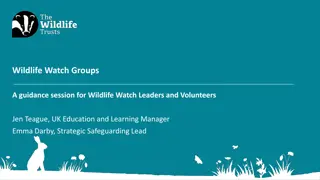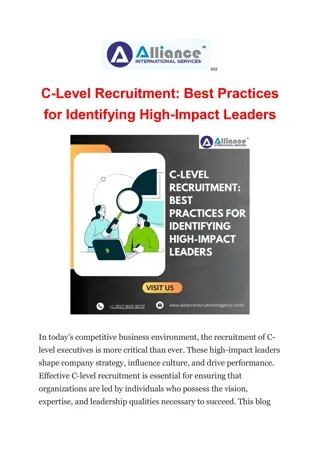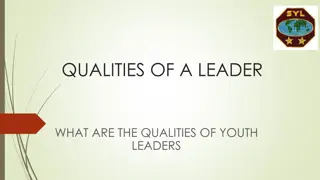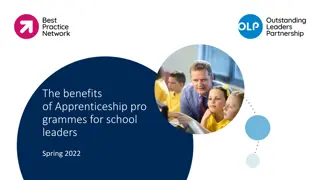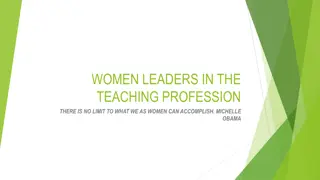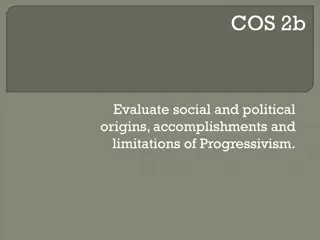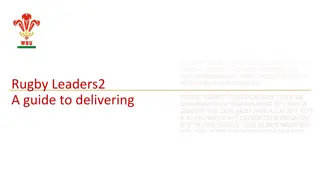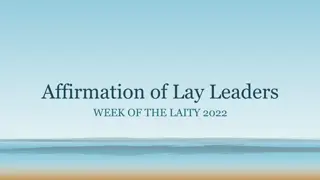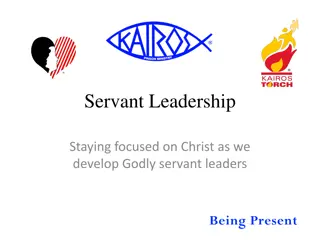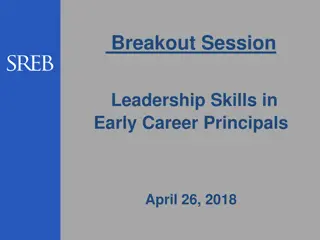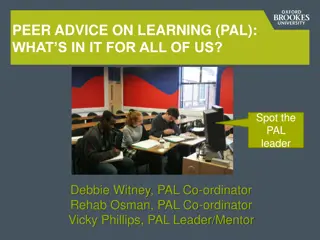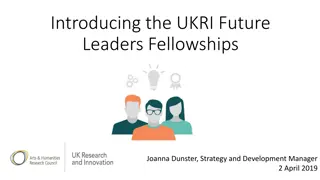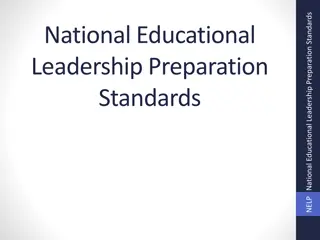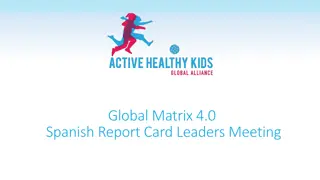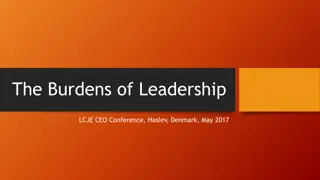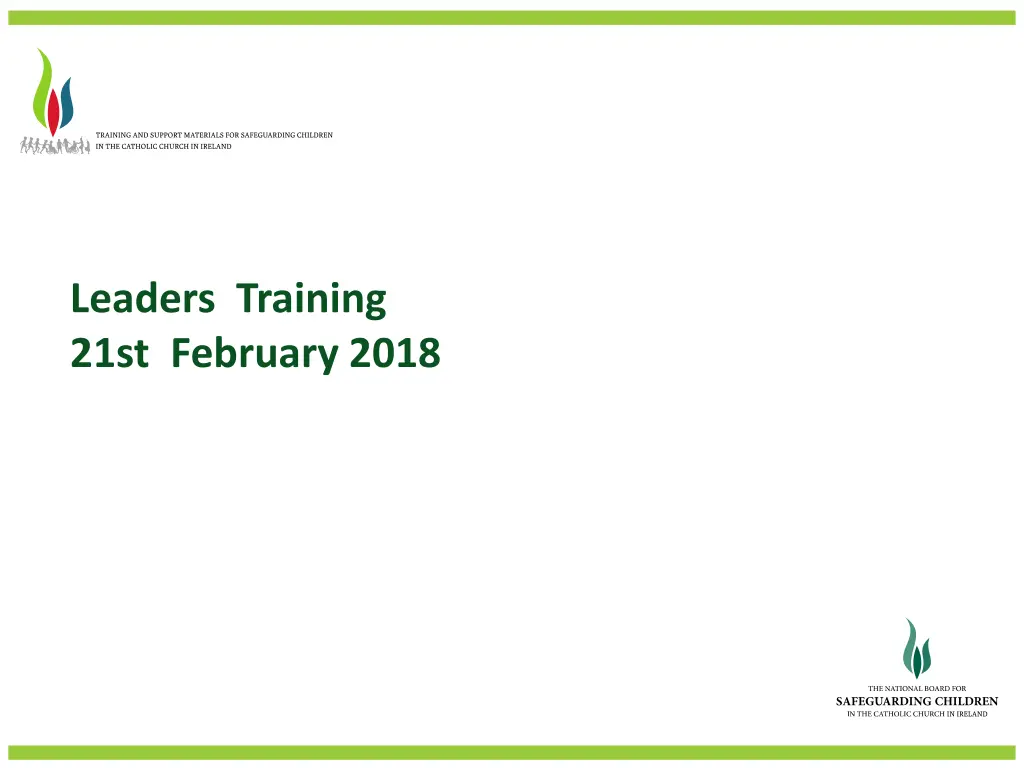
Church Leadership Training for Governance and Safeguarding
Explore the strategic role of Church Authority in governance, challenges faced, and changes post Children First Act. Understand the importance of a pastoral approach, support systems, and addressing challenges in safeguarding practices.
Download Presentation

Please find below an Image/Link to download the presentation.
The content on the website is provided AS IS for your information and personal use only. It may not be sold, licensed, or shared on other websites without obtaining consent from the author. If you encounter any issues during the download, it is possible that the publisher has removed the file from their server.
You are allowed to download the files provided on this website for personal or commercial use, subject to the condition that they are used lawfully. All files are the property of their respective owners.
The content on the website is provided AS IS for your information and personal use only. It may not be sold, licensed, or shared on other websites without obtaining consent from the author.
E N D
Presentation Transcript
Leaders Training 21st February 2018
Welcome, Introductions and Prayer Teresa Devlin
Aims for the Day To discuss the strategic role of the Church Authority in terms of governance and identify challenges associated with your role To discuss recent changes following enactment of the Children First Act 2015 To discuss the importance of a pastoral approach in working with complainants
Role of the Church Authority To be responsible for all safeguarding practices by: Ensuring that the appropriate child safeguarding structures and personnel are in place; Liaising with the Holy See, as appropriate. If the Church body is a religious order or congregation, this is done through the superior general; Ensuring compliance with canon and civil law; Upholding the seven standards in practice and behaviour.
Who needs support? Complainant Respondent Congregation Safeguarding Personnel You
What kind of support? Complainant- Towards Healing, Toward Peace, Support Person Respondent- Counselling, Adviser Congregation- Counselling Safeguarding Personnel Supervision You - Supervision
Challenges How is it resourced? How is confidentiality maintained? Difficulty in trust? How are objectives set and achieved?
Bullet Point 1 and 4- Upholding the Standards and ensuring the safeguarding Structure is in place
Terminology, Website and App Terminology used throughout this presentation and where it can be found in the Policy and Standards document 1. Policy is pages 8-12 2. Policy Statement is the first two paragraphs of page 8. The wording of these paragraphs cannot be changed or adapted in any way. 3. Standards are set out on page 13 4. Indicators are the standards broken down and are grouped into 3 categories: 1. Ministry with children (Table 1) page 16 2. Those with no ministry with children but are managing cases (Table 2) page 18 3. Those with no ministry with children (Table 3) page 20 5. Procedures are the written documents you need to help assist with practice to live out the indicators of the standards. The guidance can help you to do this, if you need it. 6. Guidance is support for all aspects of safeguarding children and is there to assist if necessary
Ministry with Children Any work or service undertaken by Church Personnel with children, which is under the authority of their church body Any work with children undertaken by Church personnel (lay, vowed and ordained) within Church property, which is under their authority of their Church body; All priests in active ministry under the authority of their Church body are to be considered as having ministry with children.
Church Authority-Procedures Needed Access to all procedures relevant to Church body you can see the full list here https://www.safeguarding.ie/index.php/guidance-by-roles In particular: Three year safeguarding plan (for those in Categories 1 and 2) (7.2A) this includes Training Plan (5.2B) Communications Plan (6.1A) Procedure for annual report to Church Authority (7.1D) Notification letter to NBSCCCI (7.1 Template 4 or 5) List of all clerics/religious ministering outside of the Church body (1.10A) Procedure for Information Sharing (2.3A) Procedures to support complainant (3.1A, 3.2B, 3.3A)
Church Authority- Procedures Needed Procedure for Informing Respondent (4.2A) Conducting a risk assessment to produce interim management plan (4.2B) Canonical Processes (4.2C, 4.3A, 4.3B, 4.3C, 4.3D, 4.3E, 4.4A, 4.4C) Procedure for clinical risk assessment (4.4B) Procedure for accessing support (5.6A) List of Mandated Persons (2.1L) Child Safeguarding Statement (For those who have ministry with children) (6.1D) Reporting Procedure (2.1A) Visiting Clergy/religious procedure (1.1C)
Visiting Clerics/Religious from within Ireland Once off cover Be vetted in own Church body Show celebret/current letter of good standing Sign the Sacristy Register (or visitors book) Short Term Cover Be vetted in own Church body and receiving jurisdiction Show celebret/current letter of good standing which requires approval of ministry forms to be completed Confidential Declaration form Induction Agreement
Visiting Clerics from outside Ireland Once off cover Be vetted in own Church body if possible Show celebret/current letter of good standing Sign the Sacristy Register (or visitors book) Short Term Cover Be vetted in own Church body and receiving jurisdiction Show celebret/current letter of good standing and approval of ministry. Confidential Declaration form Induction Agreement
Clerics from Outside Ireland Prior to visit, where there is an intention to engage in public ministry, all visiting clerics must write seeking permission of the Church authority, giving details about the duration of the visit, the type of ministry and the location of ministry being considered. The contact details of the Church authority of the visiting priest must be provided in advance; Upon receipt of a request from visiting clerics to carry out ministry, the Church authority must acknowledge the same, and then make a request in writing to the visitor (1.1C Template 1) for a celebret or confirmation of good standing (1.1C Template 3), signed by their Church authority; The visiting cleric must be asked to complete a declaration of good standing form (1.1C Template 2); A vetting check must be carried out through the Garda National Vetting Bureau/Access NI (Guidance 1.1B);
Visiting Cleric from Outside Ireland If the Church authority is satisfied that there are no concerns about the visiting cleric, permission should be given in writing to the visitor, outlining the specified ministry, including its duration and location (1.1C Template 4); A copy of this permission (1.1C Template 4) should be forwarded to the parish priest or local superior of the visitor, and also to the parish priest or local superior of the location of the ministry outlined in the letter; A copy of the permission (1.1C Template 4) should be stored in the offices of the Church authority, in line with confidentiality and storage of information (Appendix B).
Visiting Person in any form of consecrated life Prior to their visit, where there is an intention to engage in public ministry, all visiting religious must write seeking permission of the Church authority, giving details about the duration of the visit, the type of ministry and the location of ministry being considered. Contact details of the Church authority of the visiting religious must be provided in advance Upon receipt of request from the visiting religious to carry out ministry, the Church authority must acknowledge the same, and then make a request in writing to the visitor (1.1C Template for a confirmation of good standing (1.1C Template 5), signed by their Church authority;
Visiting Person in any form of consecrated life A vetting check must be processed through the Garda National Vetting Bureau/Access NI (Guidance 1.1B); If the Church authority is satisfied that there are no concerns about the visiting religious, permission should be given in writing to the visitor, outlining the specified ministry, including its duration and location (1.1C Template 4); A copy of this permission (1.1C Template 4) should be forwarded to the parish priest or local superior of the visitor, and also to the parish priest or local superior of the location of the ministry outlined in the letter; A copy of the permission (1.1C Template 4) should be stored in the offices of the Church authority, in line with confidentiality and storage of information (Appendix B).
Other Variations See Handout
Indicator 7.1 The Church authority: Puts in place arrangements to ensure and evaluate its compliance with the safeguarding Standards at a local level; Produces a report on the level of compliance established through this audit exercise Notifies the National Board in writing of this annual audit report
Bullet Point 1 Compliance at a local level is achieved through the following: Ensuring that a local safeguarding audit is completed depending on your level of ministry with children and a report of the findings produced. (7.1C Templates1,2 or 3) If you have cases, ensuring that a report is completed of all active cases by your DLP (7.1D Template 1) If appropriate conducting monitoring visits (7.1B) Having a clear induction process for new leadership or staff (7.1E)
Bullet Point 2 Producing Reports Safeguarding Committee Designated Liaison Person Church Authority Report Report
Bullet Point 3 Once the report from DLP and report from Safeguarding Committee are received the Church Authority writes to the National Board to say that the local audit is completed and plans to address any gaps are in place. Template letters for those that are in Table 1 or 2 of the policy 7.1C Template 4 Template letter for those that are in Table 3 of the policy - 7.1C Template 5
Indicator 7.2 (Ignore if you have no ministry or cases) The Church body produces a three year safeguarding plan Guidance for this is contained in 7.2A Template 1 The plan should outline the actions identified from the local safeguarding audit and how these should be addressed
Bullet Point 2 and 3-Ensuring Compliance with Civil and Canon Law Niall Moore
Liaison with statutory authorities notification of allegations and regular meeting (Ferns report); MOU with The National Board Notification of allegations to the National Board Liaison with the Holy See to CDF or Congregation for Religious If a religious through the Superior General
New Changes Following Children First 2015 Niall Moore
Mandated Persons Mandated persons (as defined in the Children First Act 2015) are people who have contact with children and/or families and who, because of their qualifications, training and/or employment role, are in a key position to help protect children from harm Each Church body should consult the full list of categories who are classified as mandated persons under Schedule 2 of the Children First Act 2015 to establish which members of Church personnel are classified as mandated persons
Mandated Persons It should be understood that: All clerics and religious who have any ministry are to be considered mandated persons Volunteers are not mandated persons under the Children First Act 2015. However DLPs or Deputy DLPs who are volunteers are classed as mandated persons under Church standards.
Mandated Persons On completion of this process the Church authority must retain a list of all mandated persons, and ensure this is kept up to date. In developing this list Tusla have advised that there should be a clear statement of the type of roles that a Church body are listing as mandated persons then a number of mandated persons that are in the Church body against each role. For Example Clerics (25), Pastoral Workers (50), Religious (15) etc). For more information see Guidance 2.1L
Child Safeguarding Statement POINTS TO CONSIDER This only applies if you have ministry with children and are in the Republic of Ireland. It is a requirement of Tusla and the Children First Act 2015, it does not replace our existing policy
Child Safeguarding Statement WHAT I HAVE TO DO Appoint a Relevant person- these are contact people for any questions regarding the Child Safeguarding Statement Produce the Statement- we have written one for the whole Church which you can adapt it s available here https://www.safeguarding.ie/images/Pdfs/StandardsDocs/6.2D %20Template%201%20Example%20Child%20Safeguarding%20 Statement.doc Make it available on your website and email it to all Church personnel by the 1 11th of March 2018- this is a requirement of the Children First Guidance.
What do we mean by a pastoral response? Teresa Devlin
What Survivors Ask For Listened to and believed, a place to tell their story with compassion Apology & Acknowledgement Counselling/Support Assured of Safeguarding Compensation for harm Normalising their reaction to harm (Groups)
DOs Do what you say you will do Tell them what you will do Consider Lay Person as DLP Do meet face to face, not over telephone Do check out where the survivor is comfortable to meet (therapist s rooms/meeting room) Do check if it is OK to wear clerical clothing, respect if it is not Keep in touch/ provide updates Give information for Support (Towards Healing/Towards Peace) Listen, Really Listen
DOs Do understand it is a process, at one point the survivor may be too full of rage to engage, this might change, welcome them to have contact if and when they are ready Understand the rage and pain is a normal response (do not take it personally) Keep the communication simple/plain English/user friendly Continue to offer funding for support service Work with civil authorities (Gardai/PSNI/Tusla/HSC): Follow up Do make it easy for a survivor to find the DLP on the web
Donts Do not get defensive/Legalistic Do not back away from rage, pain, depression Do not see the full and final settlement as a closed case: continue to offer pastoral support Do not use the word psychotherapy ; they may find this scary; you are crazy Do not forget survivors are human, just hurt Do not make a survivor beg for support or funding for support
Management of Allegations- Zero Tolerance or Redemption Teresa Devlin
Notification of all allegations Consider Restrictions on Ministry Seek advice Advisory Panel/NCMC Conclusion of statutory investigations Preliminary investigation Interim Management plan/Permanent Management Plan
Considerations on Restrictions to Ministry What information do you have? What is the current ministry of the respondent? What are the risks?
Case Examples An allegation has been received against Brother John through Towards Healing. The information states that Gerard Green alleges he was sexually abused by Brother John in 1984 when Gerard was 12. There are no more details. What are the issues that you should consider? Should Brother Johns Ministry be restricted?


